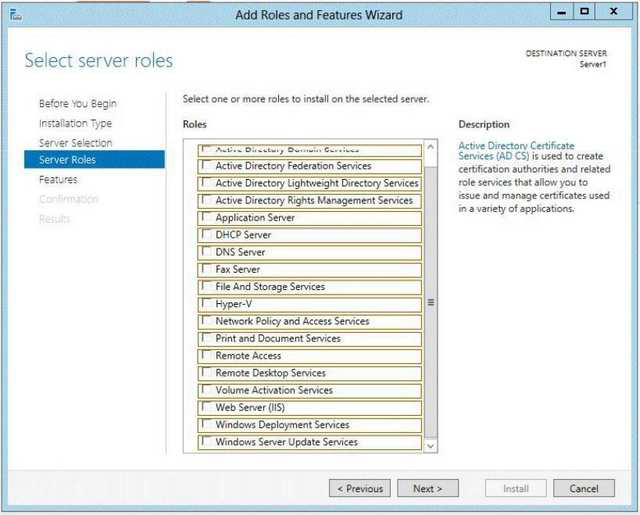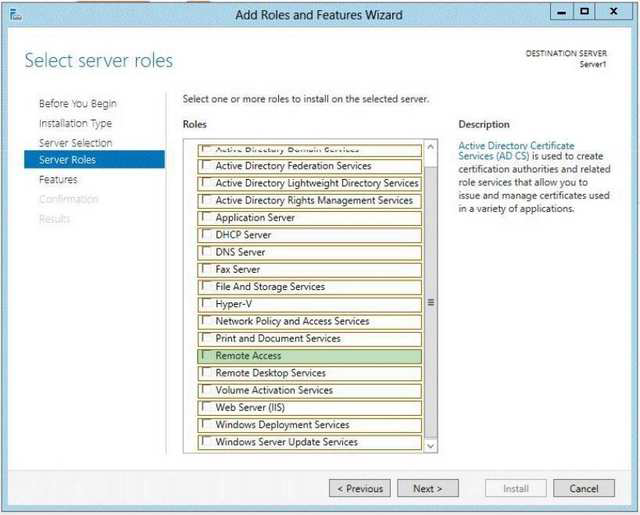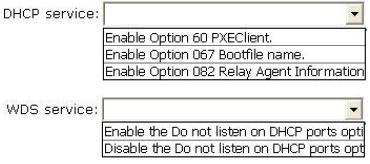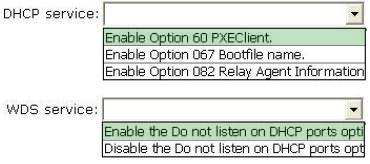READ Free Dumps For Microsoft- 70-410
| Question ID 10740 | HOTSPOT
Your network contains an Active Directory domain named contoso.com. The network contains a DHCP server named DHCP1.
You add a new network segment to the network.
On the new network segment, you deploy a new server named Server1 that runs Windows Server 2012 R2.
You need to configure Server1 as a DHCP Relay Agent.
Which server role should you install on Server1?
To answer, select the appropriate role in the answer area.
Hot Area:

|
| Option A | Correct Answer:

|
| Correct Answer | A |
Explanation Explanation/Reference: If you opt to create a centralized or hybrid DHCP infrastructure, you will need a DHCP relay agent on every subnet that does not have a DHCP server on it. Many routers are capable of functioning as DHCP relay agents, but in situations where they are not, you can configure a Windows Server 2012 computer to function as a relay agent. In Windows Server 2012 R2 the DirectAccess feature and the RRAS role service were combined into a new unified server role. This new Remote Access server role allows for centralized administration, configuration, and monitoring of both DirectAccess and VPN-based remote access services. Additionally, Windows Server 2012 R2 DirectAccess provided multiple updates and improvements to address deployment blockers and provide simplified management. References: http://technet.microsoft.com/library/hh831416 http://technet.microsoft.com/en-us/library/cc732263.aspx
| Question ID 10741 | HOTSPOT
You have a server named Server1. Server1 runs Windows Server 2012 R2 and has the Windows Deployment Services (WDS) server role installed.
You install the DHCP Server server role on Server1.
You need to ensure that Server1 can respond to DHCP clients and WDS clients.
What should you configure for the DHCP service and the WDS service?
To answer, configure the appropriate options in the answer area.
Hot Area:

|
| Option A | Correct Answer:

|
| Correct Answer | A |
Explanation Explanation/Reference: Traditionally, only DHCP listened on port UDP 67, but now WDS also listens on port UDP 67 WDS and DHCP are installed on the same server: You must tell WDS not to listen on port UDP 67, leaving it available for DHCP traffic only. But then how does the client find the WDS server? You set option 60 in DHCP. The DHCP option 60, when set to "PXEClient" is used only to instruct the PXE clients to try to use a PXE Service bound on UDP port 4011. Actually, if there is a bootp or dhcp service bound on UDP port 67 of a host (usually called a server), a PXE service cannot bind on that port on that host. Since the PXE Service uses BOOTP/DHCP packets to send the options 66 and 67 to the clients, it needs to be able to bind to the associated port (bootps) or to an alternated port (4011) that the clients know they must use as the alternate port. And to instruct the clients to use this alternate port, you have to set dhcp option 60 to "PXEClient". If Windows Deployment Services and DHCP are running on the same computer, configuring Windows Deployment Services to not respond to any client computers will not work. This is because although Windows Deployment Services will not respond, DHCP will. You should disable WDS if you have both installed and using DHCP. To configure Windows Deployment Services to run on the same computer as Microsoft DHCP Right-click the server and click Properties. On the DHCP tab, select Do not listen on port 67 and Configure DHCP Option #60 Tag to PXEClient. This procedure does the following: Sets HKEY_LOCAL_MACHINE\SYSTEM\CurrentControlSet\Services\WDSServer\Parameters \UseDhcpPorts to 0. Adds the option 60 PXEClient tag to all of your DHCP scopes.